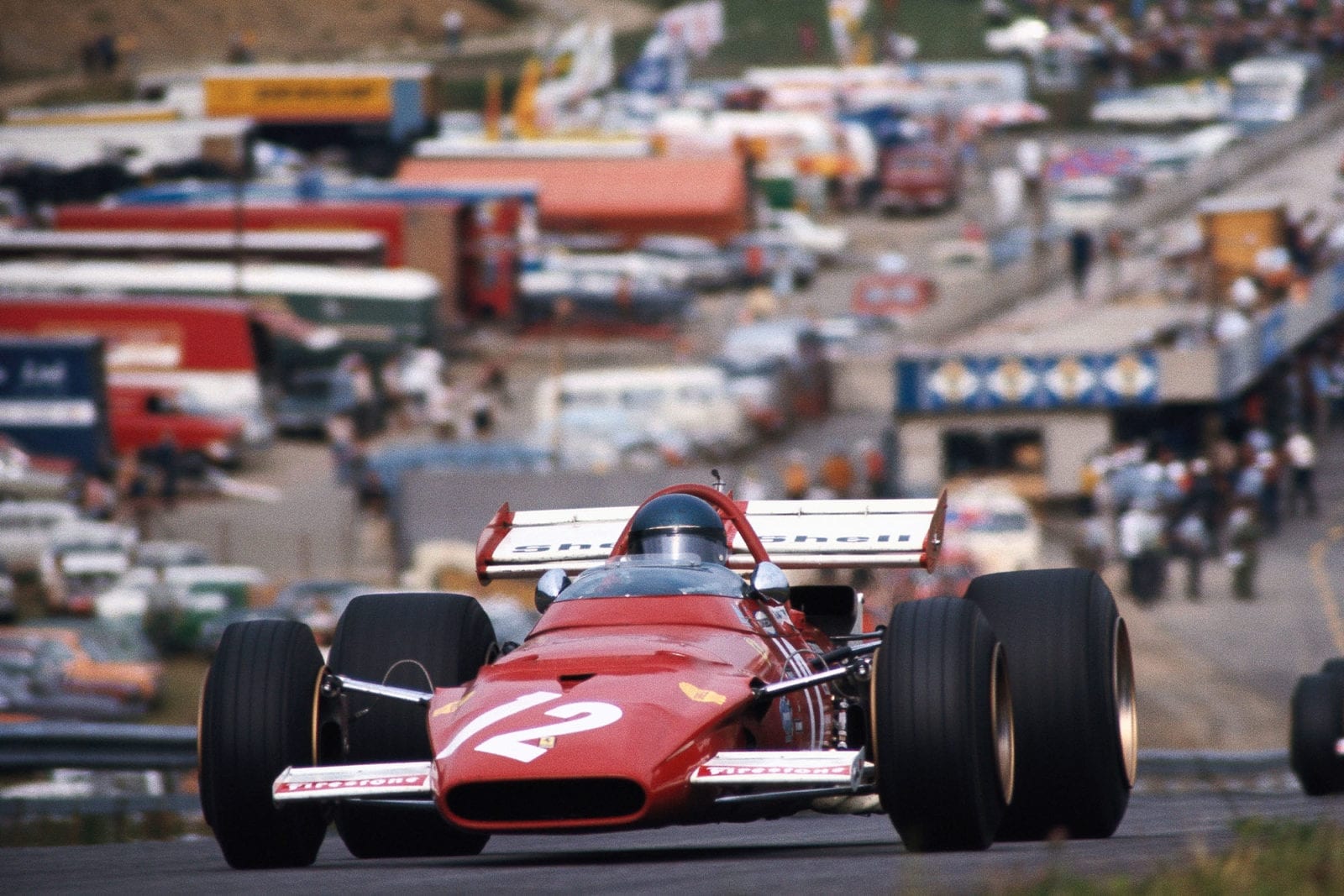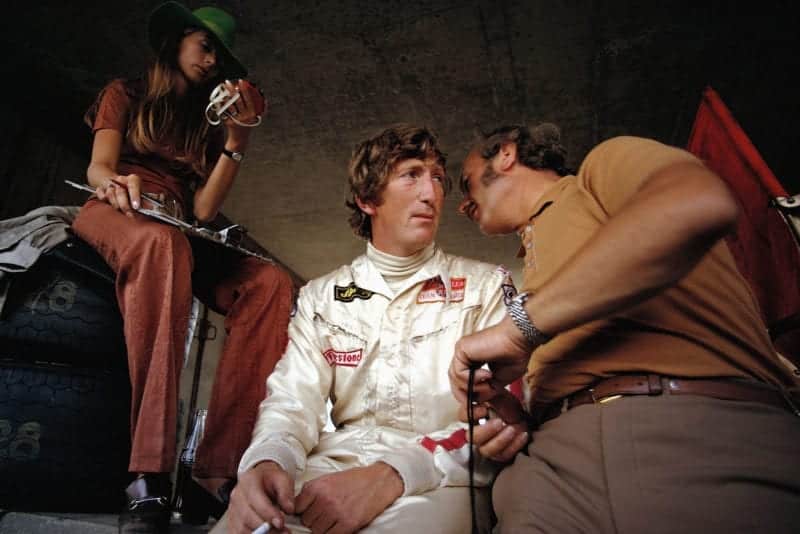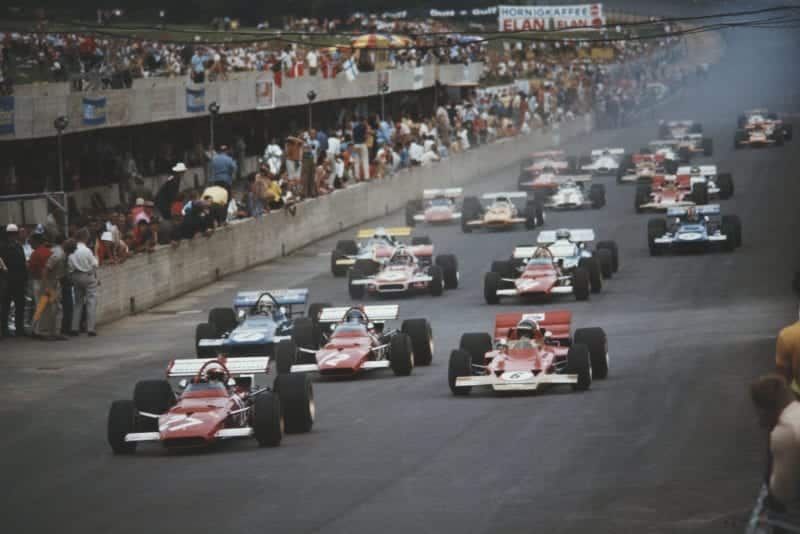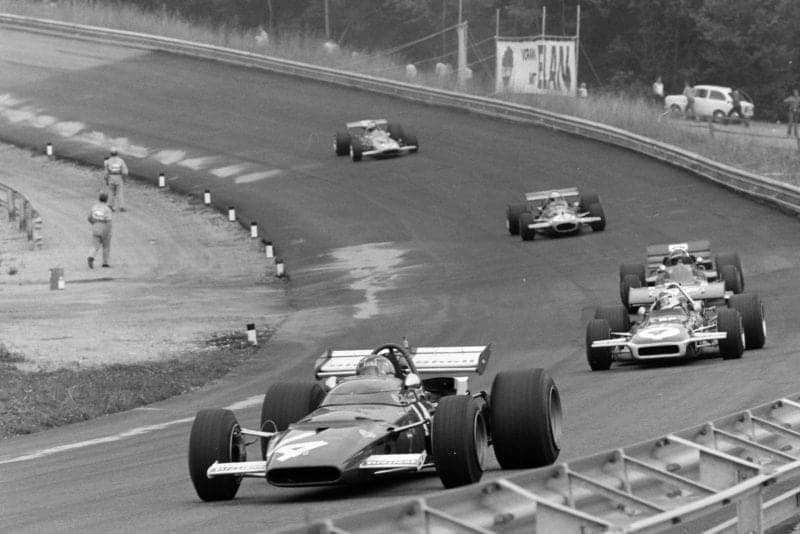1970 Austrian Grand Prix

Jacky Ickx took his first win of the season for Ferrari in Austria
Motorsport Images
Forza Ferrari
Zeltweg, Austria, August 16th.
There was a very definite “feeling” in the air as I drove over the mountains towards the centre of Austria, to Zeltweg where the Austrian Grand Prix was to be held on the new Osterreichring. It was to be the first Wold championship Grand Prix to be held on the new circuit, the previous Grand Prix of this season, held in Germany, had seen the new Lotus 72 win its fourth victory in a row, but Ferrari was getting stronger and stronger and challenged the Lotus very seriously at Hockenheim; the cars using Cosworth engines were on the decline as regards engines, for reliability was fast disappearing and replacement parts and overhauls were getting behind schedule. The feeling that the Grand Prix scene was reaching a major change it its history was heightened by both Ferrari and BRM having four cars each at the circuit and three entries each, the Italian team in a strong position with Ickx as leader and Regazzoni and Giunti backing him up well, both having made good impressions in their first season of Grand Prix racing. A very large support force of spectators for Ferrari was pouring in from Norther Italy and the Austrian countryside seemed to be alive with Grand Prix fever, motoring sport in Austria being in the throes of a boom, actively spurred on by the victories of Jochen Rindt, who is regarded as a native of Vienna, even though he was born in Germany and now lives in Switzerland. The Osterreichring was opened last summer with a sports-car meeting and then a 1,000-kilometres sports-car race as part of the Manufacturers’ Championship. It is a permanent circuit carved out of the grass and fir-clad hillside overlooking Zeltweg and the airfield where the old Zeltweg races used to be run, and is one of the better artificial circuits. It follows the contours of the land so that it abounds in steep climbs, sharp descents, falling-away curves and has five completely blind hill-brows, beyond which are fast curves, so that a driver must know exactly where he is going and be precisely “on line”. On each of these brows there are light signals which can be switched on to give warning of incidents happening over the top. If the circuit lacks anything it is a slow corner or a sudden change of direction that calls for maximum braking, but apart from that it is a satisfying circuit on which to drive, while the pits and paddock area are large and spacious and well able to cope with a proper Grand Prix meeting.
Qualifying

Jochen Rindt took pole for Lotus
Motorsport Images
All told there were elven hours of practice time available, starting with three hours on the Thursday afternoon before the face, and continuing with four hours on Friday and Saturday afternoons, so that no one could complain that they could not get ready for a one and three-quarter hour race. This being the first Grand Prix event on the new circuit the only standards to go by were those of the previous sports-car races, when the fastest lap was 1 min. 46.6 sec., and it only needed the first afternoon of practice for a bogey time of 1 min. 40 sec. to be established, an average speed of over 212 k.p.h. this was set up by the wo Ferrari new boys, Regazzoni with 1 min. 40.4 sec. and Giunti with 1 min 40.9 sec., both driving flat-12-cylinder Ferrari 312B cars. Ickx missed the first practice and when he did arrive he came with a terrible cold and not feeling too bright. The Yardley-BRM team also missed the first practice due to the transporter arriving too late, but Eaton was able to practice with his own car as it had come on ahead on a trailer. There were twenty-six entries listed altogether and twenty-four arrived, the two forfeits being Hill with Rob Walker entry as their new Lotus 72 was not finished in time and the old 49C had been pensioned off, and Peterson with the Antique Automobiles March 701 through lack on an engine. Most of the teams that were using Cosworth engines were running with their fingers crossed and hoping they would not suffer any breakages for there was a desperate shortage of supplies from Northampton, though some day and night transport driving was bringing some spare engines for some of the teams. The pace that the two Ferrari recruits set in the first afternoon was somewhat demoralising and depressing to a log of their opponents and the Friday practice was a little better, for Ickx joined in and was immediately with the other wo Prancing Horse cars from Maranello. Rindt was a bit late starting practice on Friday as the Lotus 72s had to have their side radiator scoops narrows as a rival team had protested that the overall width of the car was beyond FIA regulations, this being since the cooling scoops were revised after the Spanish Grand Prix and was something the RAC scrutineers missed at the British Gran Prix! (Strange how a car suddenly becomes illegal when it is successful.) Once under way again Rindt was the only possible challenger to the Ferraris and though Regazzoni was fastest for a long time, with 1 min. 39.7 sec. and Ickx was just behind him with 1 min 39.8sec., Rindt raised the Cosworth hopes just before practice finished on Friday afternoon with a lap in 1 min. 39.2 sec. There were the only ones to break the 1 min. 40 sec. barrier, though a few came close, Stewart and Giunti being equal with 1 min. 40.2 sec., though the Italian recorded it first, and Beltoise, Amon and Cevert were close up behind, the young French driver of the second Tyrrell car doing a courageous lap in the slipstream of one of the Ferraris to tow him along to an excellent, if artificial 1 min. 40.9 sec.
In all other directions there was trouble. Brabham started by using Stommelen’s new car, but the engine broke, so he took his own car back from the German lad, Eaton went off the track in a big way and wrecked his BRM, and Miles spun off into the barriers with the latest Lotus 72 and bent the rear end. Surtees gave the Friday a practice a miss as his TS7 was going well and he had to conserve his one and only Cosworth engine, but Andretti was far from happy with his STP-March 701, modified by the German-based McNamara factory. The Williams team were giving Schenken his first Grand Prix drive, in the De Tomaso, as Redman was occupied elsewhere racing for Chevron, and the McLaren team were in full force, Hulme and Gethin with the Cosworth-powered cars and de Adamich in the Alfa Romeo engine car, with ex-Ferrari engineer Marelli now working for the Autodelta Alfa-Romeo racing department. The Tyrrell team were not very active, the two cars spending a lot of time resting at the pits, while Stewarts spare car 701/2 was left in the transporter, but the Matra-Simca V12s were going round on full song and sounding as strong as ever.
The final practice session saw everyone start off rather cautiously, anticipating an end-of-afternoon battle for the high places on the starting grid, though no-one had to qualify as the Austrian club agreed to accept twenty-four starters. A vast crowd, estimated at 20,000, turned up on the Saturday afternoon, which made the financial situation look decidedly healthy for the organisers and those who had financed the building of the Osterreichring. Once more the Ferraris were setting the pace with Regazzoni at 1 min. 40 sec. and Ickx two-tenths of a second slower, but half-way through the afternoon it began to rain and came down so heavily for a time that all hope of the circuit ever drying out was gone, and all the plans for a last-minute assault on grid positions had to be abandoned. As the rain settled in there was a complete cessation of activity, but then Surtees went out to find what the new circuit was like in the wet, and he was soon followed by Regazzoni and Giunti, the last named in the pare car 312/004 with Ickx’s number on it. Then Schenken went out in the De Tomaso, and Rindt and Pescarolo joined in, all on heavy treaded rain tyres. AS the rain eased off, although the track remained very wet, Rodriguez, Andretti, Oliver, Miles, Moser and Amon all went out. Before the session ended the rain stopped but he circuit did not dry out and though most of the drivers were out for a final fling there was no hope of any fast times being recorded. The Brabham team were still in trouble for Stommelen took back the newer car, with another engine fitted, but it broke almost before he had got warmed up, and Brabham’s engine was fitted, but it broke almost before he had got warmed up, and Brabham’s engine was giving trouble necessitating unbolting the engine from the monocoque in front of the pits to put things right. Team Lotus had repaired the newer Type 72 which Miles had bent, but the Yardley-BRM team made no attempt to repair Eaton’s car as he was due to take over the spare one for the face, one Rodriguez decided which he wanted to use. The Saturday practice finished on a rather subdued note compared to what had been anticipated, and it looked as though Rindt was going to be surrounded by Ferraris.
As there were some ties on the practice times the Austrian time-keepers produced a set of practice results to two-places of decimals to decide the ties, which gave Steward 1 min. 40.2 sec. and Giunti 1 min. 40.21 sec., having both been given 1 min. 40.2 sec. originally. However the Stewards of the meeting realised that timing was being done by hand-operated stop-watches and refused to accept the second place of decimals, so Stewart and Giunti were put back on equal time, with the note that Giunti had done his at 15.09 hours on Friday and Stewart had done his at 15.54 hours on the same day, so Giunti was ahead of Stewart on the grid and as the organisers had changed the starting grid layout from 3-2-3 to 2-2-2, it meant that Stewart was back in row three. Tyrrell immediately continued his attitude of “if you can’t win, protest” and refused to accept the findings of the Stewards on the grounds that times to two places of decimals had been published so they had to stand. The scene began to look like the Spanish G.P. and a pleasant friendly meeting was being spoilt by too much professionalism, but it all subsided and Stewart was re-instated on row two, with Giunti on row three, and though Ferrari were not pleased about it they were happy to have one of their cars in each of the first three rows, with Regazzoni alongside Rindt on the front row.
Race

The race starts
Motorsport Images
The crowd that turned out for practice had been a portent of the enthusiasm of the Austrian grand Prix and by mid-day on Sunday, with the weather warm and fine an enormous crowd was pouring into the Osterreichring, covering the hillsides like ants, and an estimated 100,000 attended, though people who do not like the thought of a race being too successful were putting the crown at 70-75,000. A short Formula Ford race was held at mid-day, to get things under way, and was won by Peter Lamplough driving the works Palliser FF, from two Austrian-driven McNamara cars. After the Grand Prix drivers had been paraded round the circuit in Morgan +8s, Marcos, and Beach Buggies, they went off on a warm-up lap in the racing cars and lined up on the dummy-grid in pairs, offset from each other.
Shortly after 3 p.m. the Austrian flag fell and the twenty-four starters were away to a superb start, with Regazzoni in 312/003 taking the lead and Ickx in 312/001 right behind him. Regazzoni led on the opening lap, followed by Ickx, Rindt, Giunti in 312/002, Beltoise and Amon, and as they all flashed by the pits Stewart was hurtling down the pit road holding himself up out of the driving seat of March 701/4 as there was petrol leaking into the cockpit. Half-way round the second lap Regazzoni felt he had the situation well in hand so he waved his team-leader by, and Ickx took the lead. Rindt was with them, but getting by one Ferrari was one thing, getting by two Ferraris was another thing altogether, and he had the third one right in his mirrors. As if having Stewart in the pits was not bad enough for Tyrrell, his second car burst its engine in a big way, spreading oil everywhere, and Cevert started walking back to the pits. When the leaders arrived at the oil on lap 3 there was quite a bit of dodging about, and Beltoise, Giunti and Amon all nipped by Rindt, pushing the Lotus driver back into sixth place so that there were now four 12-cylindered cars in a row, the first three beginning to pull out a small lead. Whereas Ickx had Regazzoni right with him as a tower of strength in support, and Giunti not far behind, Rindt was all on his own, for Miles can never hope to match the pace of the Austrian driver. On lap 4 he did net even get the chance to try for one of the shafts to the inboard front brakes failed and the new Lotus 72 was out of the race. While the leading trio were away on their sixth lap Stewart rejoined the race with the leaking fuel pipe repaired, but he had little hope of getting anywhere, as happened to him at Clermont-Ferrand.
After recovering from being elbowed back in such an unseemly manner at the oil incident, Rindt began to speed up again and soon passed Amon, and by lap 10 had passed Giunti, but by this time Ickx, Regazzoni and Beltoise were 8 sec. ahead, a long way at an average of around 130 m.p.h. The leading trio of 12-cylinder cars were singing round merrily nose to tail, and were gaining on Stewart and in view of lapping him for he could not match their pace, but before it could happen he was back in the pits again, this time to retire. At ten laps the order was Ickx (Ferrari), Regazzoni (Ferrari), Beltoise (Matra), Rindt (Lotus), Giunti (Ferrari), Brabham (Brabham)-, Amon (March), Hulme (McLaren) Surtees (Surtees), Pescarolo (Matra), Oliver (BRM), Gethin (McLaren and the rest. Eaton, in BRM 153/06, was enjoying himself keeping ahead of Schenken in the De Tomaso, and Moser in the Bellasi had overtaken de Adamich with the Alfa Romeo-engined McLaren, The little Swiss was forced out on lap 13 when his radiator started leaking; he had had an accident on the way to the circuit behind a police escort and had made a temporary repair at the last moment, but it had failed. On the next lap Andretti had his accelerator stick down and the STP Oil Treatment Special charged through the wire netting fences and demolished itself, the driver getting out without a scratch.

Giunti leads the chasing pack
Motorsport Images
The race pattern had settled down with Regazzoni keeping a sensible distance behind Ickx, unlike some number two drivers who feel they must sit right on the exhaust pipes of their leader, to try and impress. Beltoise could stay with the Ferraris, but that was all, and Rindt was beginning to close up by measureable amounts, the gap dropping from 7.8 sec. to 7.6 sec., to 7.0 sec. on successive laps. On lap 18 he set a new fastest lap in 1 min. 42.0 sec., but as he started lap 21 his Cosworth engine broke and that was that, all danger to the Ferraris was over. As the fuel load was used up the Ferraris went quicker, their handling improving, whereas the Matra was less affected by the lighter fuel weight, and while Beltoise could stay with the Ferraris to begin with, by 30 laps, which was half-distance, the two red cars began to pull away and on lap 38 they jointly put the lap record at 1 min. 40.9 sec., later reducing this by half second. Cosworth engines were breaking in all directions, the De Tomaso died on lap 26, the Surtees on lap 27, and Hulme’s McLaren on lap 31. Brabham was pressing hard on Giunti’s tail but eh young Italian driver was not at all impressed and dodged about in a spirited fashion to give Brabham a hard time. There were lots of stones on the inside edges of the track and clipping the corners fine was causing tyres to throw the stones up, and Brabham collected one through the radiator when he was trying to get by Giunti on lap 34. He stopped at the pits an in just over five laps his mechanics did a fantastic job of work replacing the split radiator with a new one and the Australian was back in the race. Earlier, on lap 23, Pescarolo’s Matra had collected an enormous stone thrown up by Hulme and it had struck the rear suspension and bent a shock-absorber, necessitating a pit stop and the loss of all hope of a good position.
As the two leading Ferraris were setting a new record on lap 38, Giunti had a slice of tread come off his left front tyre and he shot into the pits to have it changed. The stop cost him a full lap, and Stommelen, Amon, Rodriguez, Oliver and Gethin went by, in that order, the young German Brabham driver going very well indeed after a slow start caused by a poor grid position due to very little practice. Giunti rejoined the race in ninth place a lap behind the leaders, and just behind them on the road, so that they pulled him along as they steadily lapped the mid-field runners. With fifteen laps to go Ickx and Regazzoni were completely untroubled and were giving a fine display of team discipline and a convincing demonstration that Ferrari had returned to his former glory. The vociferous Italians in the crowd, many thousands of them, were now quiet, holding their breath for fear that something might spoil the sight and sound of the two red cars screaming round in formation. The Tyrrell transporter could be seen threading its way out of the paddock, bound for England, where the team had an appointment to unveil a new make of car to replace the rather unsuccessful March project. As 50 laps approached Amon was lapped by the two Ferraris, cars that he did not consider worthy when they were on the test at the end of the last season, and salt was rubbed into the wound when Giunti in the third one passed him and disappeared into the distance, taking seventh place from the works March. Ickx and Regazzoni were not behind Oliver and Rodriguez, about to lap them, and as the four 12-cylinder engines screamed round in close company they made a noise that must have been audible in Northampton, while just behind them a high tenor was provided by Beltoises’s Matra. Half-way round lap 56 the French song faltered as the fuel system failed yet again to pick up the last 8-10 gallons of petrol, and Beltoise shot into the pits for more petrol. By the time he was out again the leaders had gone by, to be a lap ahead, and the BRMs had also gone by, but the Frenchman was just able to stay in front of Giunti’s Ferrari. This last-minute drama let a surprised Stommelen up into third place, worthily upholding Brabham and Cosworth honours.

Ickx is congratulated upon winning
Motorsport Images
As the Ferraris go the chequered flag Italian enthusiasm burst its bonds, and waving, cheering, weeping, screaming Italians came from all parts of the spectator enclosures, bearing Ferrari Club banners, and the presentation of the victor’s laurels disappeared in a wild and delirious tumult. An hour after the finish the paddock still rang with cheering and applause.
Eight 12-cylinder-engined cars had started the race and eight finished the race, the full teams of Ferrari, BRM and Matra had recorded 100% finishes, and of the fifteen Cosworth-powered cars that started, six were running at the end. All the signs had been that a Ferrari might win the Austrian Grand Prix, but such an overwhelming success by the 12-cylnidered cars was more than anyone expected. It was an historic moment in modern Grand Prix racing.–D. S. J.
